Table of Contents
Wondering how to rank for competitive keywords? Well, the success of every business requires an effective online presence in our current digital world. Your business needs to be accessible online because the growing dependence on the internet for inquiries and services requires it. The most effective method to boost your visibility consists of achieving top Google rankings because this search engine represents the worldwide leader in search platforms. Google handles 3.5 billion daily searches which makes its vast platform essential for business-customer connection.
Not appearing among the top Google search results leads your business to miss out on lucrative chances of acquiring new customers and producing income. Any business that wants to rank in a competitive niche and succeed in the current online market needs search engine optimization of its website as its top strategic focus.
The process of beating competitors in search engine rankings and ranking in a competitive niche demands ongoing solution refinements and optimization work. Due to climbing PPC advertising costs, businesses tend to adopt SEO practices thus making this practice more competitive for the upcoming year.
Every B2B marketing team needs to put in regular work and redesign their strategies to beat the competition in search engine rankings. The pursuit of SEO victory through organic search requires extensive time alongside dedicated resources despite being the natural order of this search game.
Statistics That Highlight How Proven SEO Strategies Can Surpass The Competition
It has been known that 70% of marketers see better results when they prioritize content quality over quantity. Not just this, according to a study, it was found that Websites with more than 100 backlinks tend to rank higher on Google, with the average top-ranking page having 3.8x more backlinks than lower-ranking pages. To back up their facts, research conducted by Sweor stated that 88% of online consumers are less likely to return to a site after a bad experience, making UX optimization critical for SEO success. Not just this, 58% of all online searches come from mobile devices, and Google now uses mobile-first indexing, meaning mobile-optimized sites have a ranking advantage facilitating competitive organic rank.
Proven Strategies On How to Rank for Competitive Keywords
The following list presents several strategies that integrate traditional SEO principles with modern marketing practices to rank in a competitive niche. Your business will dominate Google search engine result pages against competitors through the implementation of these strategies for many years.
Identify Your Competitors
The businesses already established with active rankings will understand their main competitors. The opportunity to conduct competitor research presents itself at this initial stage if you have not undertaken such analysis before.
Websites that appear at the top positions of page one Google and other search engine results represent your main business competitors for targeted keywords. Your business faces companies that sell identical products while targeting equivalent customer groups.
It’s important to know that:
- Your search engine optimization competitors can exist independently from your standard business competitors.
- Your site offers multiple products or services and various blog topics leading to different competitors springing up for each specific product or service and discussion topic.
- Understanding your competitors constitutes a fundamental military approach because understanding the enemy gives you a higher chance of victory.
Understand Your Niche Better
After deciding on a niche, you will need extensive research about the chosen field. Veteran business researchers understand the importance of understanding who their market competitors are at the beginning of their work. A proper competitor analysis remains vital for your business enabling competitive organic rank.
To make an informed decision you must explore the products on each site together with their backlinks, keyword strategy, content approach and domain authority.
Additional information obtained about current market competition will help you create a better understanding of landscape dynamics.
Your analysis of the existing sites confirms the importance of the niche because excellent performance means strong market demand that you can participate in successfully. Competitor analysis helps businesses detect missing content as well as identify chances and vulnerable points in their competitor’s content.
Using identified gaps will enable you to develop your content strategy which sets you up for direct competition against existing competitors.
The analysis reveals possibilities to develop your business plan. Your analysis of competitors reveals that their audience wants services that your competitors do not offer.
The website adds profit potential through the delivery of products or services which competitors do not offer.
Discover
How Our Agency Can Generate More Traffic & Sales For You!
- SEO: Maximize traffic with top-notch SEO Services. Watch real results!
- PPC: Ignite instant lead generation with my team of PPC experts.
- Content Marketing: Unleash my team of storytellers who craft share-worthy content, attract traffic, and pull in valuable links.

Targeted Keyword Research
The identification of search terms along with query phrases through which your future customers look up information in search engines constitutes keyword research. The process of keyword research enables B2B marketing teams to find all available search engine methods that users employ in their product service search.
However, not all keywords are created equal. Having similar target keywords to your competitors does not ensure your website will rank at their level. Diverse types of keywords differ in their competitive levels. Your website needs to select target keywords that are achievable for ranking purposes.
Why? Most search engine users stop their exploration on the first results page of SERPs. Web pages with low Domain Authority and without established off-site signals through backlinks and link-building strategies will unlikely achieve first-page ranking for demanding keywords.
The selection of keywords requires you to identify the following qualities:
- Realistic Keyword Difficulty score: A Keyword Difficulty score indicates that the score should be within your website’s Domain Authority level.
- Strong Monthly Search Volume: Otherwise, your optimization will be for nobody.
- High CPCs: Indicates strong conversion potential and qualified target audiences.
- Long-tail variations of keywords: The use of long-tail keyword variants works brilliantly as a B2B search approach because it helps reach users who use detailed keyword combinations that reveal purchasing readiness but face limited competition.
The power of SEO tools must be fully integrated into keyword research activities, which is also helpful in competitive organic rank.
Improve Your Domain Authority With Backlinks and Digital PR
Keep Visitors On Your Website For Longer With Internal Links
Since the early days of SEO services, the number of backlinks has continually represented the key element for achieving superior SERP positions. Another website linking to your website indicates to Google that professional website owners trust your site along with its useful content for users.
Establishing backlinks with superior websites that have been vetted serves as the single validation criterion. The ongoing value of high-quality links surpasses how many links you have since Google evaluates websites that use excessive or low-quality link-building practices as suspicious and potential spammers.
The quantity of backlinks directly influences Domain Authority levels because many different websites can use these links to ‘vouch for’ your site. To measure your site’s current authority and monitor growth from your link-building efforts, you can use a DA Checker that instantly provides your website’s domain authority and page authority. Leveraging valuable content hosted permanently on your website will bring the maximum benefit to your backlink portfolio.
Here are some of the best link-building strategies that will continue to be Google-compliant in upcoming years:
- Digital PR: Digital PR incorporates original content distribution strategies that unite efforts from content marketing with social media capabilities and public relations outreach and SEO to gain backlinks from well-known websites.
- Guest Posting: The guest posting strategy that bloggers commonly use proves highly beneficial for their content. The process consists of submitting content to another website while simultaneously enriching their visitor experience while establishing links that lead to your online pages. The approach serves B2B brands with narrow industry expertise to collect backlinks while establishing expert status in their specific field.
- Local Citations: The first step for beginners in off-site signal building includes using a NAP citation service at monthly costs starting from $20 while outranking the local competition.
Your content strategy needs link-building as a permanent integrated component. Your anchor text strategy needs planning along with high-quality backlinks directed at reaching your preferred keywords.
The vital task is to direct potential customers toward your website but the real battle begins with retaining their stay on the page. The optimal user experience depends on allocating a simple navigation system loaded with internal connections.
Customers should not experience confusion while navigating your website because this leads to frustration in their user experience. Online success comes easily through internal link implementation because it boosts visitor retention while directing people to additional website information about your products and services.
Content optimization tools provide analysis capabilities through which they suggest appropriate internal links during blog and landing page optimization. You can achieve better internal linking by following the recommended suggestions. Internal links enable search engine crawlers to locate new web pages while allowing the crawlers to monitor website content relationships.
Create Content that Surpasses Your Market Competitors In Search Engine Rankings
Online blogs represent an effective method to expand your overall keyword placements. The quantity of content that exists on your website creates multiple possibilities for ranking.
The success of using this approach requires quality content that fits your B2B business theme. Blogs need to follow the best on-page SEO practices through the implementation of complete meta tags which should include page titles and descriptions and alt text as well as other meta elements.
Not sure what to write about? AI SEO tools will assist you when you start your work. A blog idea generator allows you to type a keyword and receive a list of topics from the leading ranked articles.
Your website requires expert authors to create blog content according to the guidance previously mentioned. The AI-powered tools provide essential assistance to beginner-level marketers who want to establish their SEO content planning system.

Is Your Business Website Not Visible On Google?
Get It Ranked On #1 Page With Us!
- Google #1 page ranking for targeted keywords
- Rank #1 on your local maps
- Increased brand engagement & sales
Do Not Forget Technical SEO Optimization
A website is only as great as its technical performance. You can have the best content in the world, but it’s unlikely you’ll reach the first page if you have not invested time and energy into technical SEO optimization.
The technical part of SEO is easy to ignore because it is more complex, and it does require some web development knowledge. Business owners who aren’t comfortable moving around in the backend of their content management systems may be missing opportunities for optimization.
You can make use of various tools to find what might be interfering with your website. Site auditors conduct full website crawling operations to check all web pages for technical SEO compliance. You gain precise insight into ranking-improving technical resolutions through complete reporting alongside step-by-step direction systems. These tools will inform you about each emerging problem that might affect your SEO results through their continuous monitoring features.
A well-functioning website will deliver better ranking results in search engine outcomes given that Google remains a system-based entity during this current year. The success of outperforming competitors depends on making your website content easily accessible to search engine bots during their crawling and indexing process as well as their content understanding phase.
Ask Customers To Leave Reviews
Don’t just wait for reviews to come. You need to actively seek customer feedback, especially from happy customers.
In the eyes of Google, positive customer reviews mean that a business is a reputable, legitimate entity. Potential clients rely on outstanding testimonials to establish your business as a trustworthy entity. Previous customer satisfaction strengthens product and service trust. Customers tend to choose to fulfil their needs from businesses that treat their customers well. Businesses should deal with poor reviews properly following a professional approach as long as they respond with speed and efficiency.
Businesses should use online reputation management solutions to automate the process of requesting customer feedback through both text messages and emails. Notifications about new reviews should be available on your chosen platform which allows you to review the customer’s message right away for appropriate response.
Conclusion
Strategic planning combined with continuous optimization and a current understanding of SEO trends leads to successful competitor outranking in digital markets. Your website’s visibility becomes better through the deployment of established SEO approaches including keyword research, on-page optimization and quality content development and link-building strategies. User experience rankings remain a priority for search engines thus professionals need to focus on making high-quality content that addresses user needs. Your website needs Technical SEO to maintain its compliance with search engine specifications through proper website structure and both speed and mobile-friendliness performance.
Examining competitor strategies alongside identifying strategic gaps in the market enables one to gain critical wisdom about operational areas that require enhancement. An assessment of user engagement metrics together with behavioural data including click-through rates along with time spent on the page aids the enhancement of search rankings. Local SEO optimization combined with voice search optimization presents two growing trends that give businesses an advantage in the marketplace.
Success with Search Engine Optimization requires continuous work and algorithm-alteration adaptation together with persistent experimentation in search engine optimization methods. Organizations using these tested techniques gain industry leadership positions while building organic visibility during their quest to achieve better search rankings against market competitors.




